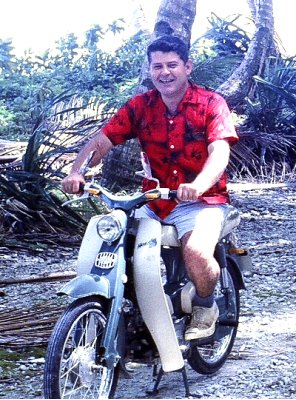
Image one
The images below were photographed by Harvey Segal and Fred McMullen, possibly others. The images were scanned by Lillian Segal. The images were then edited and adapted for display on a web page. All errors belong to the final editor. The images are not all from a single day nor necessarily a single year. The original order and sequence of the images is not known to the editor. The images have been arranged in a sequence that permits the telling of a story from this period of time in Utwe.
Identifications by Josaiah Waguk, Harvey Segal.
The images on this page are modified from the scanned images. Some images are linked to another view of the original image. For these images, click on the image to see the alternate view. All images are reduced. Some are cropped. Almost all have been rebalanced, color-shifted, or retinexed. Image numbers are arbitrary and are for reference only.
Harvey Segal was a young and energetic elementary school instructor in 1964. Harvey Segal set about holding a fund raiser for the elementary school in his new home of Utwe, Kosrae. The festival included traditional dances. Kosraeans had not danced since the missionaries and their proteges effectively banned dancing in the 1800s. Harvey first secured the blessing of the last living missionary on Kosrae, a German missionary named Anna Dederer. The church leadership, in the face of their last living missionary having consented, relented and allowed the festival to include dancing. Harvey's travels in the Pacific served him well as he taught different dances to the many different groups.
The date of the festival was early 1965, in the 1964-195 school year according to Harvey. He recollects clearly that the festival occurred after New Year's.
Utwe is a small village at sea level on the south shore of Kosrae. At that time traditional construction practices were used. The homes were elevated on pilings to keep winter high tides from flooding the sleeping floors. The shot is taken from a road that led to where Harvey lived (off camera to the right). From left to right: Leone Nena, Sepe Ezra Nena, Madlina Andrew, Kenye Andrew.
Utwe Elementary was a small, rural school with an energetic faculty teaching eager young students. Ben Benjamin held some classes outside, the students using small portable wooden tables. The students sat on the sand or on their tables.
Other classes met inside a classroom. This shot from the era is of boys from a number of grades in Utwe elementary school. The occasion may have been a Christmas concert or graduation. At the front right standing with his arm folded over the railing is Samuel Nakamura. From left to right along the front row is Robinson Benjamin, Jacob Killin, and Gerson Tilfas. From right to left (note reversal of traditional image order) second row: Harry Seymour, Reeden Kilafwakun, Robert Joseph, Nena Nakamura, Gehrig Benjamin. Rows are a bit sketchy, but such as there is a third row, right to left: Eric Waguk, James Benjamin (taller, possibly standing, slightly buck tooth), Maker Nena. Fourth row, right to left: Unnamed, Wilson Waguk (smiling, seated in front of Wilton Waguk who is facing off to photo right), Ricklin Nena, Alfred Waguk, Yoster Nena. Fourth row: Wilton Waguk (facing off to photo right), possibly Finden Benjamin, Engar Nena, Sedesin Nena, Winton Clarence (serious look, center back, hair with a distinctive part on the right (his left)), Melander Melander, Fulton Nena, Rinson Edmund. Along the back: Emius Nena, Hackley Nena, unknown, unknown, Maxson Nena, Keller Nena on chair.
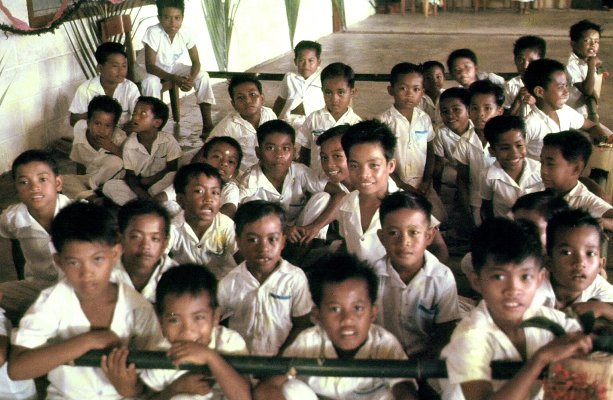
Image four
Image taken in Metais, Lelu island, at the state hospital. Dr. Austin Albert talks to the Utwe school students. Utwe school was on a field trip to Lelu and had seen the Lelu stone city. After touring the ruins the class visited the state hospital. Click on the image to access a reduced version of the original. The teacher in the left background of the original shot is Ben Benjamin.
Two trucks operated on the south side of Kosrae. Kilafwa Charley's truck was driven by Ricard Palik. The road was a couple of parallel coral paths punctuated by what only an optimist might call a bridge. Two logs counted as a bridge, one for the right tires and one for the left. Salik Palsis is on the left fender, he has passed away already.
Otneil operated the only other truck on the south side of the island. Freddy Likiaksa is on left fender, Lucy Livaie is walking on the road.
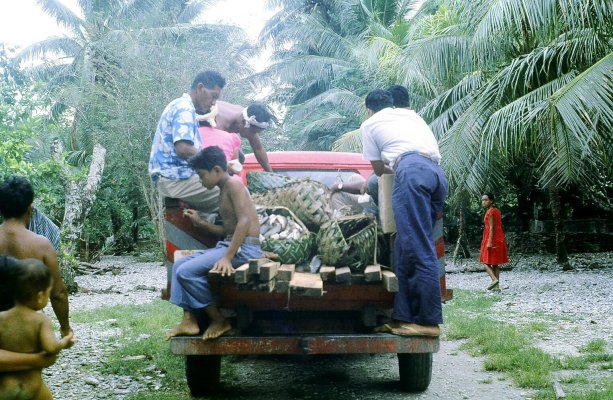
Image seven
In those days Harvey moved around using a motor scooter. Water taxis were also used for transportation. Eden Skilling worked a water taxi in Lelu harbor.
Advertising was word of mouth, and single billboard in Utwe center. In the white cap may be Godwin Joel. The billboard advertised the evening show including dancing. Tickets were twenty-five cents. Otneil Edmund, the Utwe village chief, understood that the festival was an economic opportunity for the farmers and fishermen of Utwe. The evening show was in effect "the bait" according to Harvey Segal. This drew in Kosraeans from the other municipalities. During the day local villagers sold goods to the visitors.
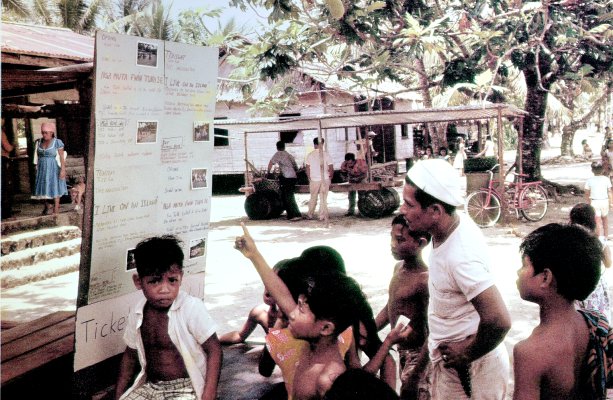
Image nine
Utwe village was busy with preparations for the festival. These animals appear to be cows, not the asian carabao found on Pohnpei. These are no longer on Kosrae. An informant indicates that the cows date back to the 1800s and attributed their introduction to Reverend Benjamin Galen Snow. Melvin Waguk is running hard behind the cow. In the background can be seen Salik Palsis, Alik Livaie, and Inac Grace Waguk.
White wash was produced by burning coral to produce lime. A line of school girls pass coral stone to fires being stoked by school boys. Sepe Honosr Waguk, Serah Livaie, Kenye P. Waguk, Kenye K. Nena, Julia Nena, Althea R. Nena, Unknown(s), Susin Waguk (at end).
Two of the girls midline. Leone Nena on the left, Julia Nena on the right. Julia would later marry Eden Skilling and can be seen together on a 2007 page done at the time of Harvey's 80th birthday.
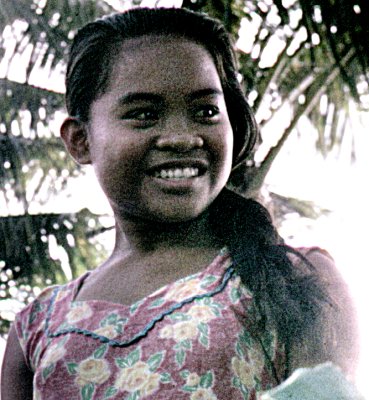
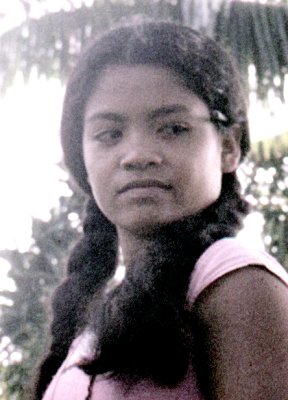
Image twelve, thirteen
Girls wove skirts. Note the use of toes to hold the bands of Hibiscus tiliaceus or lo. The hibiscus was previously soaked, cleaned, and dried, a long process that took planning and forethought.
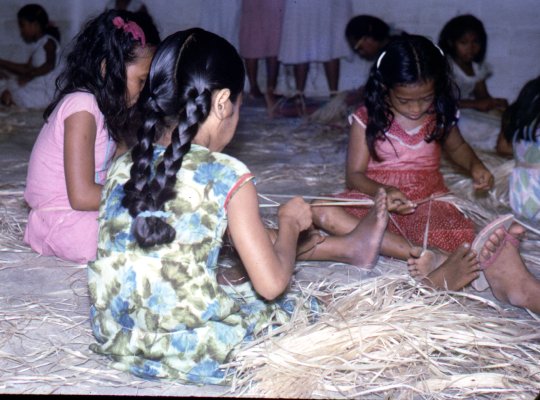
Image fourteen
Girls weaving coconut frondlets, possibly weaving decorations. The flowers in their hair are Ixora casei or kalsruh blossoms. Camihla Taulung is in pink, Rosella Tilfas in yellow. In the original Edlin Benjamin is on the right in white. In the background of the original men are working on the fence for the 1965 festival.
Foreign guests arrived by canoe and boat. There were two ways for people to get into Utwe back then, by water or on foot. While the foreigners came by water, locals walked from all over the island. In this undated image Trust Territory of the Pacific District Administrator's Representative Fred Muhleman walks along a path. The woman behind him is not, according to Harvey, his wife. Third in line is Harvey's cousin Ricky Gordon. Ricky had lived in Hawaii and spent a year on Kosrae with Harvey. Behind Ricky is Harvey.
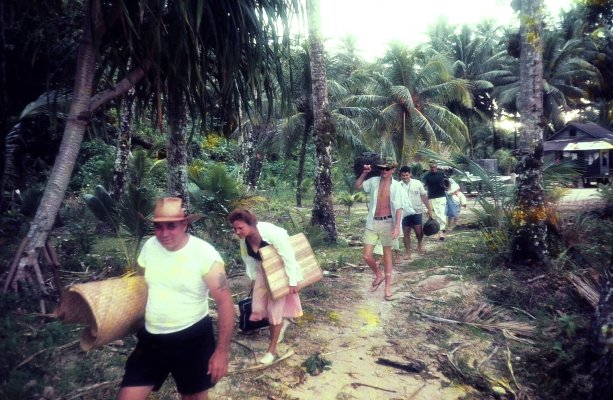
Image sixteen.
This image is taken on the Finkol bridge of the early 1960s. The data and actual occasion of the image is not known. The original image includes Terry Lindquist in a red and white striped dress, a female trust territory teacher in Malem. The men are a team of Army communications specialists. This is apparently the team that set up a LORAN antenna in the Malem school yard in 1965. This antenna was used to determine the location of a survey marker. This marker was sought by a USGS team in the early 1990s. The marker, however, was located at second base and had apparently become a problem for those sliding into second. The marker was removed at some point. The location fix was, according to the USGS team, one of the best in all of Micronesia.
Tadao Waguk with Harvey Segal.
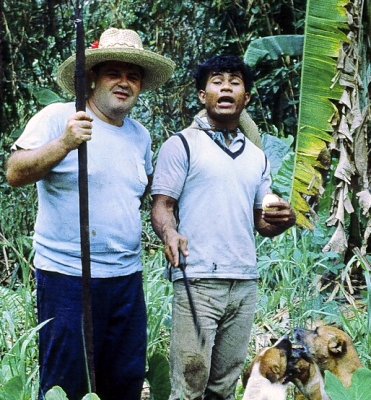
Image eighteen
Friends and family gather. The occasion for this image is not yet known to this editor. The grounds are those of the Utwe elementary school. Shrue Kenai Benjamin, Tulpe Ezra Nena, and Shrue Joseph can be seen in this image. In the original Tulpe Palsisa is on the right side of the image. Middle left Sabina N. Waguk breast feeds a baby. At the left is Tulpe Andrew, Sepe Tilfas, and Sra-falet Kun Tilfas. At the front right edge of the original image is Betsy Lee Waguk.
Daylight provided the light for group photos. The kneeling girl in the front row is Sepe Kun Benjamin. This image is from the 1965 festival.
Right to left: Rebecca Waguk, Sepe Lafokfok Waguk, Sepe Nena, Lipia Nena. Continuing to the left in the original: Kenye Obed, Elca Nena, Marylee Edmund, Maggie [Mitson], facing the camera is Sra lulu.
In this image from 1965, in the second row on the right end of the line looking towards the camera is Josaiah Waguk.
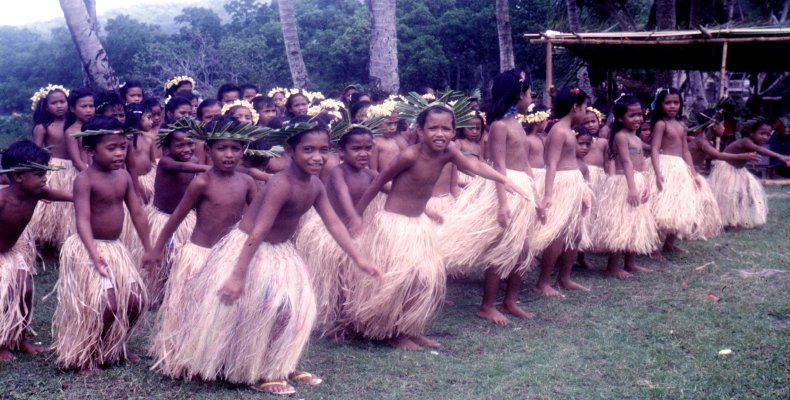
Image twenty-two
Events began under daylight. This is the seventh grade girls. Left to right in the original: Madlina P. Andrew, Kenye P. Nena, Elizabeth F. Waguk, Leone K. Nena, Sepe E. Nena, Kenye P. Andrew, Unknown, Susan Waguk.
With the arrival of evening, dancers prepared for their performances. Palik Tolenkun gets his forehead painted by teacher Ben Benjamin. Ben Benjamin would later be a senior pastor in Utwe. Roughly left to right: Palik Tolenkun, Gerson Tilfas, Clarence Walter Tulenkun (at back), Houston Waguk (also at back), Alfred Waguk, Gehrig Benjamin (foreground, washed by flash).
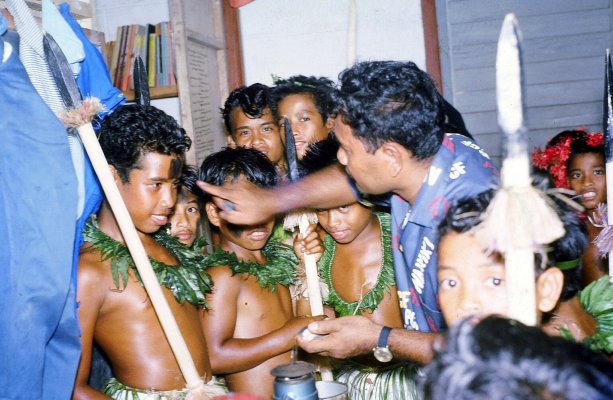
Image twenty-four
In the image on the left below, Kester Joel can just be seen in the lower-right hand corner of the photo. To Kester's right is Yoster Nena, and Ritel Tilfas. The original can be accessed by clicking on the image below. In the original Josaiah Waguk and Elsie Waguk round out the front row. Behind Kester is Madison Nena. Behind Elsie is Alfred Waguk. In the original along the back wall is Serah Livaie, Paul Waguk is by the window. On the right below is Raylina Waguk.
Music was provided by an acoustic guitar band accompanied by a single electric guitar. The electric guitarist was Alik Livaie, later mayor of Utwe. The amp was battery powered, there was no electricial power in Utwe in 1965. Also in the band were Klava Tolenkun, Tolensru Kilafwakun, Timothy Nena, Aaron Waguk.
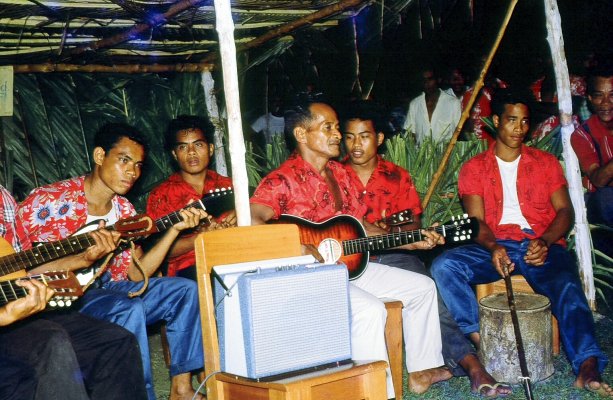
Image twenty-seven
The bead necklaces in the image below were made from fiti ituc (Calophyllum inophyllum).
Many young Kosraeans today are unsure of the materials used to make the necklaces. Sepe Tadao Waguk still makes the necklaces. As Sepe is originally from Lelu, it might be that Tadao taught Sepe how to make the necklaces.
Senelyn Tadao Waguk, later Senelyn Edmund, worn a fiti ituc mwarmwar and necklace in a circa 1999 performance. Senelyn is Sepe and Tadao's daughter. Sepe Tadao Waguk was still producing the necklaces in 2007.
To make the necklaces, the insides were removed, then the nuts were dried. Later they were painted. The bead necklaces were, according to Josaiah Waguk, Harvey's invention. Harvey notes he had seen similar necklaces in Hawaii. His specialization in teaching science with available materials proved useful in the hunt for materials out of which to make the necklaces. He had seen youngsters using the fiti ituc to play marbles. Josaiah notes that the first few attempts ended in failure. Success came when the hole that was drilled was made smaller. From right to left along the front two rows: Victor Melander, Yoster Nena, Anson Nena, Jane Clarence (in the white shirt, only the second one down the front row), Early Slavin, Domick Tilfas, Hadley, Shrue Clarence.
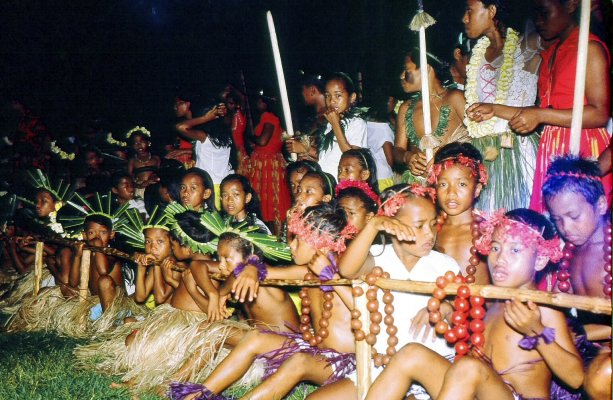
Image twenty-eight
In the image below on the right is Tulpe Kinere.The flower mwarmwar is for, plumeria blossoms.
Tulpe Kinere is kneeling, facing to her left. The frontmost boys are Finden Benjamin and Hadley Waguk. Directly behind Finden is Jeff Benjamin with a red flower mwarmwar. Since passed away, Jeff would go on to become a doctor and the FSM secretary for health, education, and social services. Just behind Jeff and to Jeff's left is Patterson Benjamin.
Harvey talks to the dancers. In the background on the right is Erafe Tosie. Directly "under" Harvey's torso is Killin Killin. Lighting was a real concern and Harvey puzzled over how to light the night dancing for some time. He eventually devised lights by cutting one side off of a ship biscuit tin and putting kerosene lamps inside the tins. He also noted that he was aided by the presence of a full moon. There was no back up plan in case of rain, and fortune kept the evening dry and moonlit. Harvey noted that while he cannot remember the exact date, he remembers the festival as being in the spring, possibly March.
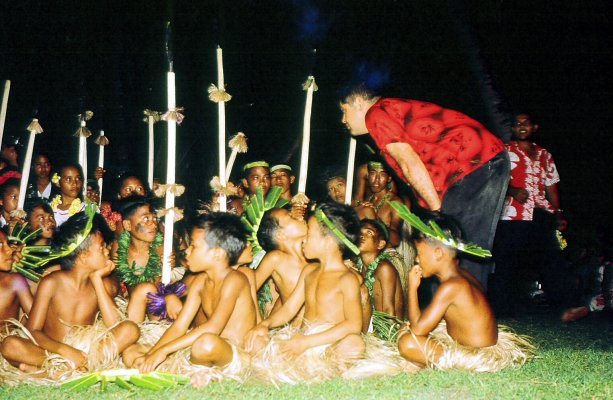
Image thirty-two
Eighth grade girls at the 1965 festival.
The images appear to end with this night dance shot. Noting the high resolution of the original images with which the editor was working, his best guess is that film speeds were too slow to capture the movement of night dancing. Even the shot above shows signs of motion blur.
The following image was taken in Lelu. The girls are from Yekula high school in Tafunsak. Yekula was the only high school on the island. The Yekula high school students were divided into three teams: red, white, and blue. The picture is of the white team. Julina Noda on the left, Antelise Sigrah to her left, show the joy they felt that day. Julina would later marry Lyle Timothy, Antelise would marry Yosiwo George and become a first lady of Kosrae.
The eighth grade graduating class from school year 1964-1965. Left to right, front row: Clarence Tolenkun, Vanston Waguk, Houston Waguk, Serah Livaie, Annette Benjamin, Julia Nena, Madlin Waguk. Second row: Slavin Tilfas, Moses Alik, Rosina Waguk, Althea Nena, Hadleen Benjamin. Third (back) row: Winfield Paulino, Nena Shrew Nena, Justice Joseph, Rensely Livaie, John Clarence, Shra Nena, Wihper Obed, Killin Killin, Lucy Livaie, Sepe Waguk.
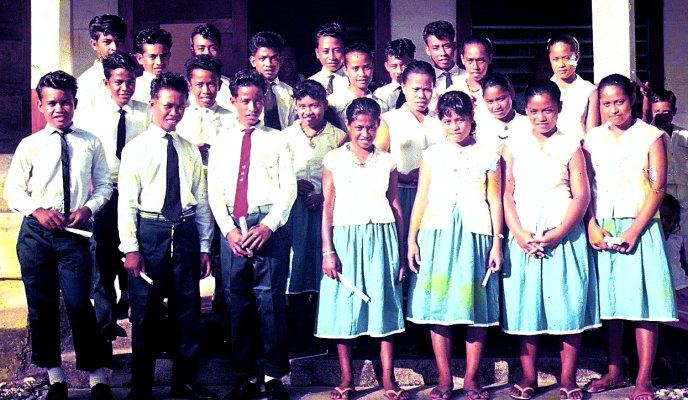
Image thirty-five
Corrections, comments, and clarifications can be sent to Dana Lee Ling.